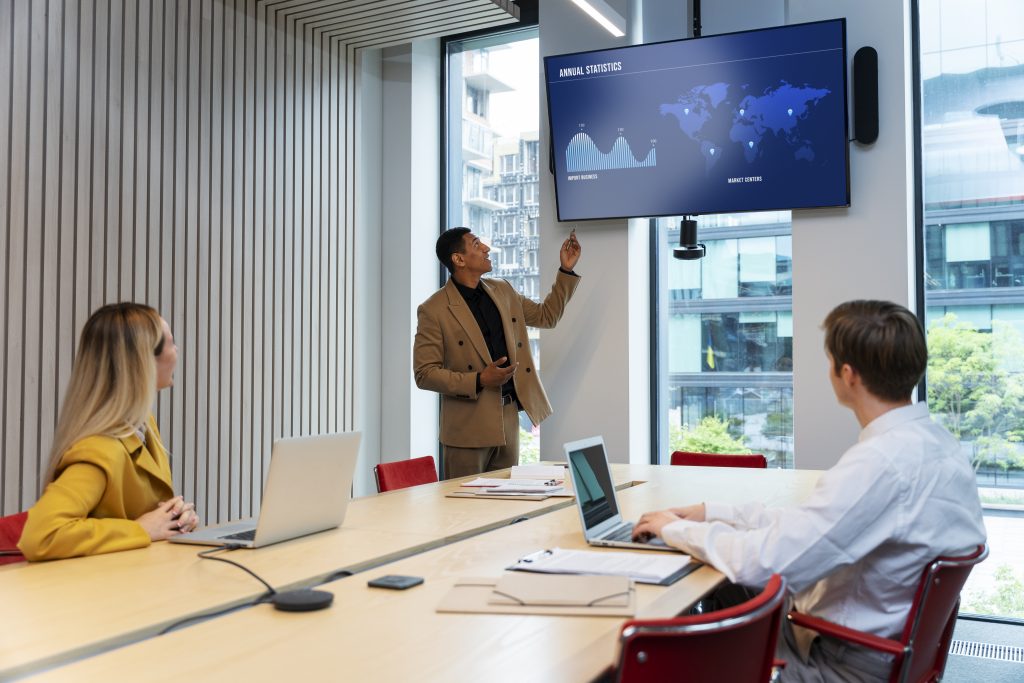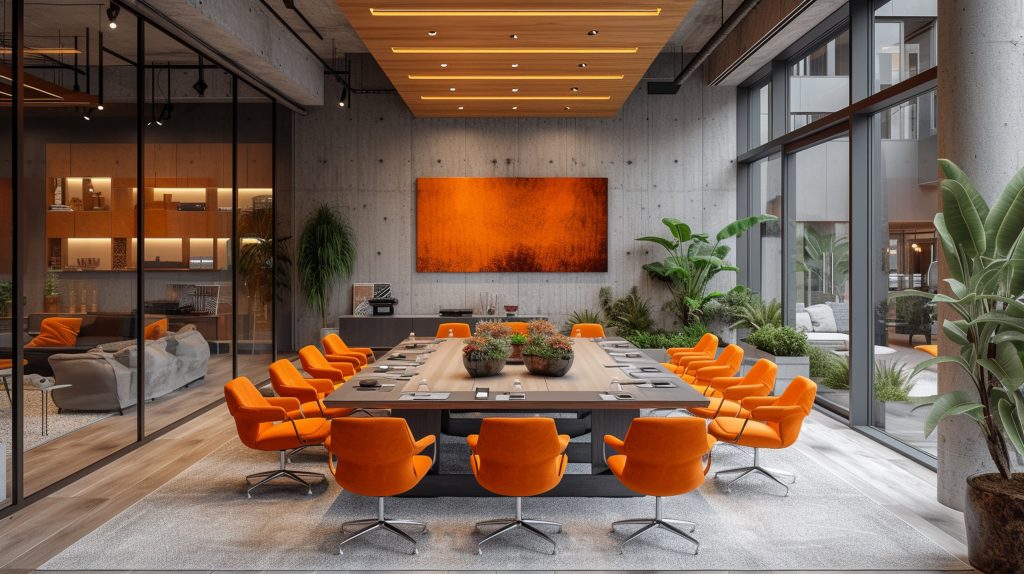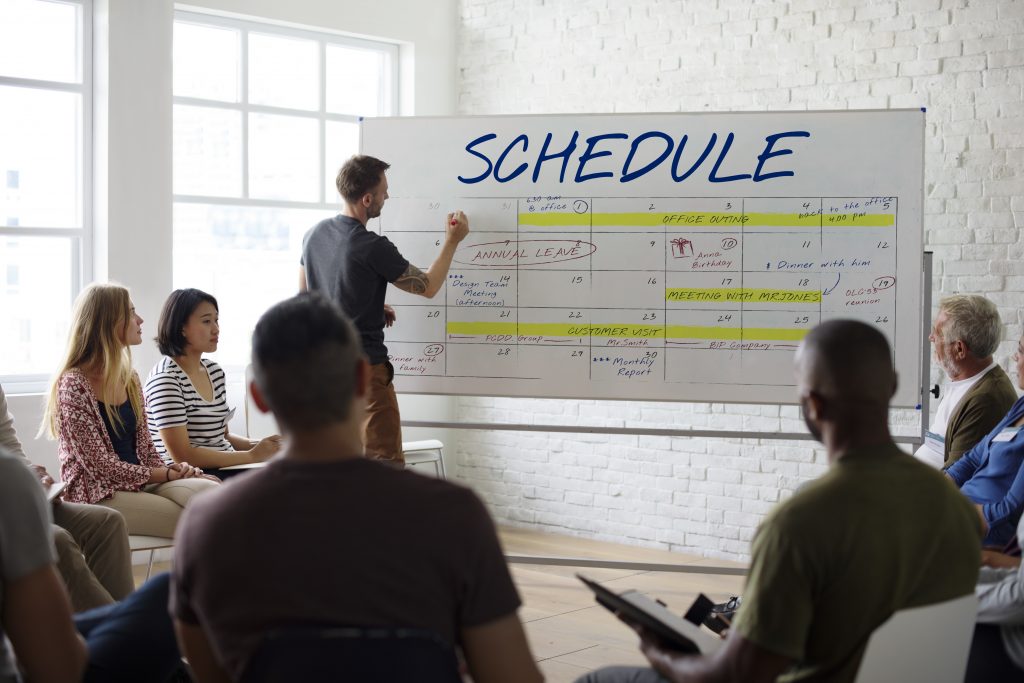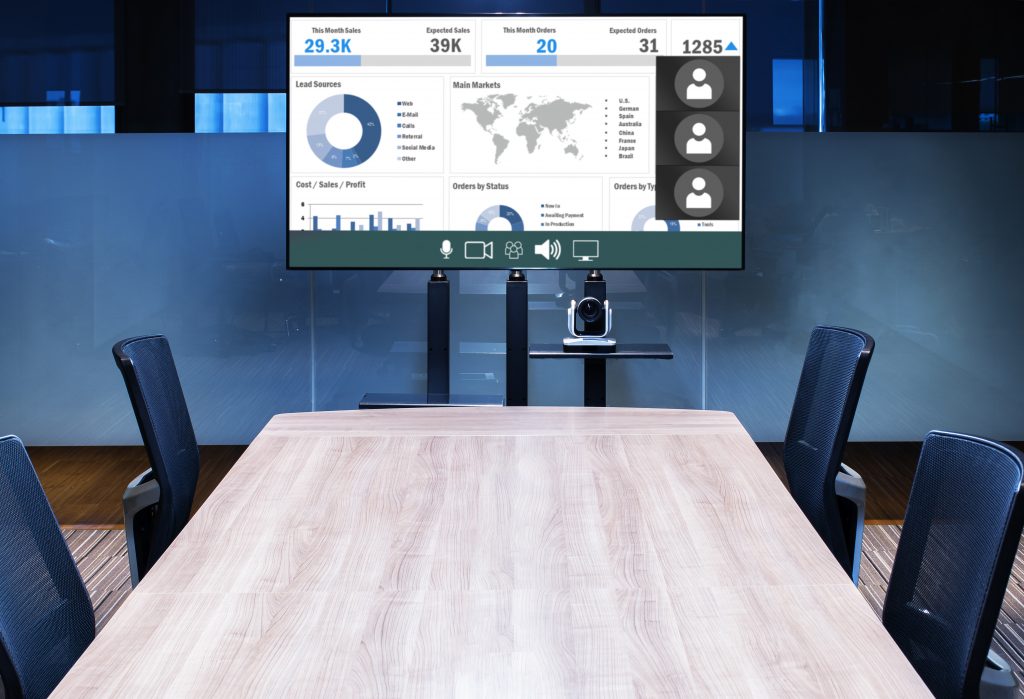Introduction
Meeting room planning effectively is crucial in today’s fast-paced business world. The design and functionality of meeting rooms can significantly influence the productivity and creativity of teams. This introduction explores several key aspects to consider for optimal meeting room setup, including space efficiency, technological integration, and comfort and aesthetics, ensuring that every meeting facilitates communication and enhances collaboration. Here are several key aspects to consider for optimal meeting room setup:
- Space Efficiency: Understanding the spatial dynamics to accommodate various meeting types, from large presentations to small brainstorming sessions.
- Technological Integration: Equipping rooms with the necessary tools for seamless connectivity and interaction, such as high-quality video conferencing systems, which have become indispensable in the hybrid work model post-2020.
- Comfort and Aesthetics: Creating an inviting atmosphere through ergonomic furniture and adequate lighting to keep attendees engaged and comfortable.
As we delve into these elements, it’s important to reference industry benchmarks and guidelines. For example, the General Services Administration (GSA) offers insights on space planning that can serve as a valuable resource for optimizing room layouts and equipment choices (GSA Guidelines).
Understanding Your Space Requirements

Creating an effective meeting room starts with a clear understanding of space requirements. This not only ensures comfort but also enhances the functionality of the space. Let’s break down the key factors to consider when assessing room capacity and layout, and why flexible space design is crucial for modern work environments.
Assessing Room Capacity and Layout
The first step in optimizing your meeting room is to assess its capacity and layout. This involves several crucial considerations:
- Maximum Capacity: Determine how many people the room should accommodate. This depends on fire safety laws and the typical size of meetings expected.
- Room Dimensions: Measure the space to ensure it fits the necessary furniture while allowing comfortable movement for all attendees.
- Furniture Setup: Plan the arrangement of tables, chairs, and equipment. U-shaped, classroom, and boardroom styles are common layouts that cater to different interaction levels and meeting purposes.
Using a tool like RoomSketcher or similar online layout planners can help visualize and plan the space effectively. For instance, RoomSketcher provides options to experiment with different layouts virtually, which can be very helpful in planning (RoomSketcher).
Importance of Flexible Space Design
In today’s dynamic work environment, flexibility in meeting room design is more important than ever. Here are some reasons why flexible designs are beneficial:
- Adaptability: Spaces that can be easily reconfigured for various types of meetings—from large training sessions to small team huddles—are invaluable.
- Technology Integration: Flexible rooms can more readily adapt to new technologies, which is essential as digital tools and platforms evolve.
- Cost-Effectiveness: Instead of multiple rooms each dedicated to specific purposes, a flexible room can serve multiple functions, which saves space and resources.
Key elements of flexible space design include:
- Modular Furniture: Items like stackable chairs and foldable tables make it easy to change the room’s setup quickly.
- Mobile Partitions: Use partitions to divide a large room into smaller, more intimate meeting areas as needed.
- Tech-Ready: Ensure that power outlets, data ports, and good Wi-Fi coverage are accessible from multiple points in the room.
Implementing these aspects not only makes your meeting space more adaptable but also future-proofs it against changing business needs. Organizations like the International Facility Management Association provide guidelines on managing and utilizing spaces efficiently, offering resources that can further enhance your planning (IFMA). By understanding your space requirements and emphasizing flexibility in design, you can create a meeting environment that is both effective and inspiring, ready to accommodate whatever your business needs might be.
Integrating Technology for Enhanced Collaboration

In the modern workplace, technology is the backbone of effective collaboration. Integrating the right technology into your meeting rooms can significantly enhance communication and efficiency. Below, we’ll explore essential technologies for modern meeting spaces and provide tips for integrating these technologies seamlessly.
Essential Tech for Modern Meeting Room planning
To facilitate dynamic and productive meetings, several technologies have become indispensable:
- High-Quality Video Conferencing Systems: Essential for remote collaboration, these systems should offer high-definition video and clear audio.
- Smart Boards and Interactive Displays: Replace traditional whiteboards with interactive displays for real-time collaboration and multimedia presentations.
- Wireless Connectivity Solutions: Tools like Apple AirPlay and Google Cast allow for seamless sharing from any device to the meeting room’s main display.
- Sound Enhancing Equipment: Acoustic panels and microphones can drastically improve audio quality, which is crucial for both in-person and virtual participants.
- Efficient Lighting Controls: Automated lighting systems not only save energy but also help set the right mood for meetings with adjustable settings.
For instance, Cisco’s WebEx Room Kits provide a comprehensive solution by integrating smart cameras, noise-canceling microphones, and connectivity options that enhance virtual meeting experiences (Cisco WebEx).
Tips for Seamless Technology Integration
To ensure the technology in your meeting room planning Meeting Room Planning Meeting Room Planning Meeting Room Planning Meeting Rooms enhances rather than hinders your meetings, consider the following tips:
- Start with a Needs Assessment: Understand the specific needs of the people who will use the room. This helps in selecting technology that complements the daily workflow.
- Ensure User-Friendliness: Choose technologies that are intuitive and easy to use to minimize training requirements and maximize adoption.
- Regular Updates and Maintenance: Keep software and hardware up to date to avoid glitches and security breaches that could impede meetings.
- Provide Training and Support: Offer training sessions and easy-to-access support for all integrated technologies to ensure all users feel comfortable.
- Test Configurations Regularly: Regular testing helps catch issues before they become problematic during important meetings.
By integrating technology thoughtfully, you create a more flexible and productive environment conducive to modern work demands. For more comprehensive guidance, refer to TechCrunch’s article on technology trends in meeting rooms, which discusses the latest innovations and how companies are implementing them (TechCrunch). Implementing these technologies and following these integration tips will transform your meeting rooms into effective hubs for collaboration that drive productivity and innovation.
Design and Aesthetics

The design and aesthetics of a meeting room play a crucial role in the effectiveness of the meetings held within. A well-designed room not only facilitates communication but also enhances creativity and focus. Below, we delve into how to choose the right decor and furniture and discuss the importance of lighting and acoustic considerations in creating an optimal meeting environment.
Choosing the Right Decor and Furniture
Selecting the appropriate decor and furniture for a meeting room requires a balance between functionality and style. Here are some key points to consider:
- Ergonomics: Choose furniture that supports the well-being of attendees, such as ergonomic chairs and adjustable tables.
- Style Consistency: Ensure that the decor matches the company’s branding and culture. This consistency helps reinforce the company’s identity.
- Flexibility: Opt for modular furniture that can be easily reconfigured for different meeting types and group sizes.
- Quality and Durability: Invest in high-quality materials that will withstand frequent use and maintain a professional appearance over time.
For example, Herman Miller is renowned for offering a range of office furniture that combines ergonomics with elegant design, making it a popular choice for businesses looking to furnish their meeting spaces (Herman Miller).
Lighting and Acoustic Considerations
Proper lighting and acoustics are essential for maintaining energy levels and ensuring clear communication in any meeting room. Here’s how to optimize these elements:
- Natural Light: Whenever possible, incorporate natural light, which has been shown to boost mood and productivity. Use blinds or shades to control glare and heat.
- Task Lighting: Provide additional lighting options like LED panels or adjustable desk lamps to cater to different tasks and preferences.
- Soundproofing: Use acoustic panels, carpets, and ceiling tiles to reduce echo and external noise, which are crucial for maintaining focus during meetings and for effective teleconferencing.
- Microphone and Speaker Systems: Install professional-grade microphones and speakers to ensure that everyone can hear and be heard clearly, especially in larger rooms.
Incorporating these design elements effectively can significantly impact the productivity of meetings. According to a study published by the Illuminating Engineering Society, well-designed lighting can improve the comfort and efficiency of meeting spaces, thereby enhancing the overall meeting experience (Illuminating Engineering Society). By carefully considering these aspects of design and aesthetics, you can create a meeting room that not only looks great but also promotes a productive and engaging meeting environment.
Best Practices for Meeting Room Scheduling

Efficient scheduling is key to maximizing the use of meeting rooms and minimizing disruptions in a busy workplace. By implementing best practices for meeting room scheduling and employing the right tools, organizations can enhance productivity and ensure that all teams have fair access to meeting spaces. Below, we explore how to use scheduling software effectively and strategies to avoid double bookings.
Utilizing Scheduling Software
Scheduling software is an essential tool for managing meeting spaces efficiently. Here are some benefits and tips for using these systems:
- Centralized Booking: Use a centralized system where all employees can view and reserve meeting spaces in real time. This transparency helps prevent conflicts and double bookings.
- Integration Capabilities: Choose software that integrates with your organization’s calendar systems, such as Google Calendar or Microsoft Outlook. This integration ensures that meeting times are synced with personal employee schedules.
- Mobile Access: Ensure that the scheduling software has a mobile app or mobile-friendly version, allowing employees to book rooms from anywhere, which is especially useful for remote or hybrid teams.
- Features to Look For: Opt for software that offers features like automatic reminders, equipment booking options, and customizable room settings.
Popular tools like Robin Powered provide robust solutions for managing meeting spaces and integrating with existing office systems, enhancing the ease of scheduling across the organization (Robin Powered).
Strategies to Avoid Double Bookings
Double bookings can cause significant disruptions. Here are strategies to prevent them:
- Clear Policies: Establish and communicate clear policies regarding meeting room bookings, such as how far in advance rooms can be reserved and how long they can be held without confirmation.
- Real-Time Updates: Ensure that the scheduling system updates in real time. Immediate synchronization across all platforms prevents multiple employees from booking the same space.
- Confirmation Requirements: Implement a requirement for meeting confirmations 24 hours in advance; otherwise, the reservation is canceled, and the room becomes available for others.
- Overbooking Protocols: Develop protocols for handling overbookings, such as immediately notifying involved parties and providing alternative solutions.
Following these strategies helps maintain a smooth operational flow and ensures that meeting spaces are used efficiently and fairly. For further insights, Harvard Business Review discusses the impact of effective meeting management on organizational productivity, highlighting the importance of reliable scheduling practices (Harvard Business Review). By integrating advanced scheduling software and employing strategic policies, businesses can significantly improve their meeting room usage, making sure that these essential resources contribute effectively to workplace efficiency and collaboration.
Case Studies

Analyzing real-world examples provides invaluable insights into the dos and don’ts of meeting room design. This section examines both successful setups and lessons learned from less effective designs, offering practical takeaways that can be applied to improve any meeting space.
Successful Meeting Room Setups
Several organizations have demonstrated best practices in meeting room design that result in enhanced functionality and user satisfaction. Here are key examples:
- Tech Company in Silicon Valley: This company equipped its meeting rooms with state-of-the-art video conferencing systems, dynamic lighting controls, and modular furniture. The flexibility and technological integration have increased meeting efficiency and worker satisfaction significantly.
- Global Consulting Firm: By adopting a user-centered design, this firm has rooms that vary by size and technology, catering to different meeting purposes—from large presentations to confidential discussions. The design includes soundproofing, ample natural light, and ergonomic furniture, creating an optimal environment for long meetings.
- Co-working Space in New York: This space features creative meeting areas with themes and tech setups that inspire innovation and collaboration. They use smart booking systems that integrate with users’ personal calendars, reducing booking conflicts.
For more detailed case studies, including specific data on increased productivity and employee satisfaction, visit the Business Insider article that covers innovative office designs (Business Insider).
Lessons from Failed Meeting Room Designs
Learning from mistakes is just as crucial as replicating success. Below are some common pitfalls in meeting room design:
- Overemphasis on Aesthetics: A startup once focused heavily on ultra-modern designs which, although visually appealing, neglected user comfort and technological needs. The result was a beautiful space that was hardly ever used for actual meetings.
- Neglecting Acoustic Planning: A medium-sized enterprise experienced issues with echo and noise transmission between meeting rooms due to poor acoustic planning. This oversight led to distractions and hindered the effectiveness of meetings.
- Inadequate Tech Support: Another common issue was found in a company that installed high-end technology without training staff or setting up necessary support systems, leading to underutilization.
A comprehensive analysis by Forbes on common office design mistakes highlights these and other issues, offering solutions to ensure functionality and user satisfaction (Forbes). By examining these case studies, organizations can better understand how to create effective meeting spaces that foster productivity and adapt to the evolving needs of their teams. Whether learning from successful implementations or rectifying past mistakes, each case offers valuable lessons in meeting room planning optimization.
Conclusion

The success of a meeting room planning goes beyond its walls; it embodies the synthesis of thoughtful design, technological integration, and effective management practices. As we’ve explored, optimizing meeting spaces in your organization can lead to enhanced collaboration, productivity, and ultimately, business success. Here are the key takeaways from our discussion:
- Holistic Approach: Successful meeting room setups require a blend of aesthetics, functionality, and technology. Striking the right balance ensures that the space is not only pleasant but also practical and conducive to productive meetings.
- Embrace Flexibility: Adapting to the diverse needs of today’s workforce means incorporating flexible design elements that can accommodate various meeting types and technological demands.
- Leverage Technology: Effective use of scheduling software and the latest conferencing technologies can eliminate common logistical issues, such as double bookings and inadequate meeting facilities.
- Learn from Others: Both successful and unsuccessful case studies provide valuable lessons. Emulating the successes and avoiding the pitfalls seen in other organizations can steer your meeting room designs toward efficiency and user satisfaction.
For further insights and detailed case studies on optimizing office spaces, the Harvard Business Review offers a range of articles and resources that delve into creating effective work environments (Harvard Business Review). By implementing these strategies, you can ensure that your meeting rooms are not just spaces but dynamic environments that foster innovation and efficiency. Whether you are redesigning a single room or multiple spaces across a global enterprise, the principles outlined in this article will guide you towards creating meeting areas that are truly beneficial for your organization’s goals.
As you seek to implement these strategies for more productive and efficient meeting environments, Spotbooker offers the perfect platform to simplify your booking process. Visit Spotbooker today to streamline how you manage and reserve your meeting spaces, ensuring your team can focus on what truly matters.






